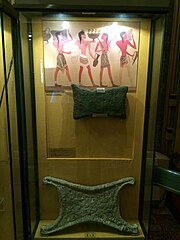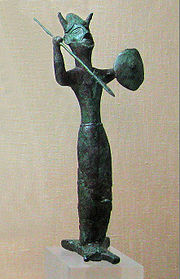
Back صبة جلد الثور Arabic Ochsenhautbarren German Lingot à peau de bœuf French Lingotto a pelle di bue Italian Lingote couro de boi Portuguese Öküz gönü külçeleri Turkish
Oxhide ingots are heavy (20–30 kg) metal slabs, usually of copper but sometimes of tin, produced and widely distributed during the Mediterranean Late Bronze Age (LBA). Their shape resembles the hide of an ox with a protruding handle in each of the ingot’s four corners. Early thought was that each ingot was equivalent to the value of one ox.[1]: 138 However, the similarity in shape is simply a coincidence. The ingots' producers probably designed these protrusions to make the ingots easily transportable overland on the backs of pack animals.[1]: 140 Complete or partial oxhide ingots have been discovered in Sardinia, Crete, Peloponnese, Cyprus, Cannatello in Sicily, Boğazköy in Turkey (ancient Hattusa, the Hittite capital), Qantir in Egypt (ancient Pi-Ramesses), and Sozopol in Bulgaria.[2][3] Archaeologists have recovered many oxhide ingots from two shipwrecks off the coast of Turkey (one off Uluburun and one in Cape Gelidonya).
- ^ a b Pulak, Cemal (2000), "The Copper and Tin Ingots from the Late Bronze Age Shipwreck at Uluburun", in Yalçin, Ünsal (ed.), Anatolian Metal I, Bochum: Deutsches Bergbau-Museum, p. 138, ISBN 9783921533796
- ^ Muhly, J. D. (1986). "The Role of Cyprus in the Economy of the Eastern Mediterranean". In Karageorghis, V. (ed.). Acts of the International Archaeological Symposium "Cyprus between the Orient and the Occident" Nicosia, 8–14 Sept. 1985. Nicosia: Department of Antiquities, Cyprus. pp. 55–6. ISBN 9789963364077.
- ^ Lo Schiavo, Fulvia (2005). "Oxhide Ingots in the Mediterranean and Central Europe". In Lo Schiavo, Fulvia; et al. (eds.). Archaeometallurgy in Sardinia. Montagnac: Éditions Monique Mergoil. p. 307. ISBN 9782907303958.
© MMXXIII Rich X Search. We shall prevail. All rights reserved. Rich X Search


